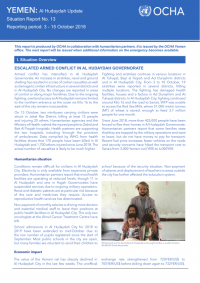Yemen: Al Hudaydah Update Situation Report No. 13, Reporting period: 3 – 15 October 2018
This report is produced by OCHA in collaboration with humanitarian partners. It is issued by the OCHA Yemen office. The next report will be issued when additional information on the emergency becomes available.
I. Situation Overview
ESCALATED ARMED CONFLICT IN AL HUDAYDAH GOVERNORATE
Armed conflict has intensified in Al Hudaydah Governorate. An increase in airstrikes, naval and ground shelling has resulted in scores of civilian casualties as well as damage to civilian infrastructure in several districts and in Al Hudaydah City. No changes are reported in areas of control or along major frontlines. Due to the ongoing fighting, overland access to Al Hudaydah remains limited to the northern entrance as the route via Kilo 16 to the east of the city remains inaccessible.
On 13 October, two minibuses carrying civilians were struck in Jabal Ras District, killing at least 15 people and injuring 20 others. Humanitarian agencies and the Ministry of Health rushed the injured people to Zabid and Bait Al Faqiah hospitals. Health partners are supporting the two hospitals, including through the provision of ambulances. Data compiled by WHO from health facilities shows that 170 people have been killed in Al Hudaydah and 1,700 others injured since June 2018. The actual number of casualties is likely to be much higher.
Fighting and airstrikes continue in various locations in At Tuhayat, Bayt al Faqiah and Ad Durayhimi districts and in Al Hudaydah City. From 3 to 10 October, 19 airstrikes were reported in several districts, hitting multiple locations. The fighting has damaged health facilities, houses and a factory in Ad Durayhimi and At Tuhayat districts. In Al Hudaydah City, fighting continued around Kilo 16 and the road to Sana’a. WFP was unable to access the Red Sea Mills, where 51,000 metric tonnes (MT) of wheat is stored, enough to feed 3.7 million people for one month.
Since June 2018, more than 425,000 people have been forced to flee their homes in Al Hudaydah Governorate.
Humanitarian partners report that some families state that they are trapped by the military operations and want to leave, but do not have money to pay for transport.
Recent fuel price increases, fewer vehicles on the roads and security concerns have hiked the transport cost to Sana’a from 3,000 Yemeni rial (YER) to 6,000YER.
Humanitarian situation
Conditions remain difficult for civilians in Al Hudaydah City. Electricity is only available from expensive private providers. Humanitarian partners report that most health facilities are operating at reduced levels, though 11 in Al Hudaydah and one in Hajjah Governorates have suspended services due to ongoing military operations.
Renal and diabetic patients are at particular risk because of the care and medicines they require. Access to reproductive health services has deteriorated.
Non-payment of monthly salaries is driving more doctors and essential medical staff to leave their positions at public health facilities in Al Hudaydah City. The only two oncologists at the Almal Cancer Treatment Centre have left.
School admissions in Al Hudaydah City for 2018 to 2019 have been extended to mid-October due to the low number of pupils registered since the start of September. Most public schools in the city are open, but many families are reluctant to send their children to school because of the security situation. Non-payment of salaries and displacement of teachers to areas outside the city has further affected the education system.


